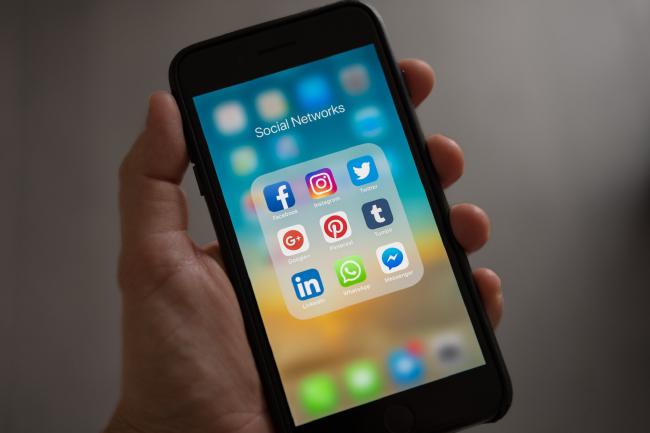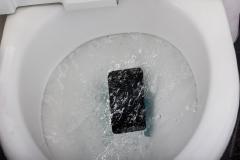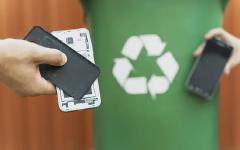Categories
5 tips to reduce your phone’s carbon footprint
6 minute read

Mobile phones have made our lives more streamlined than ever. In fact, it almost seems unfair to call them ‘phones’. They do much more than that. They’re our cameras, our televisions, our satnavs, our calculators, our flashlights, and even our credit cards.
Because they pack so much tech into one device, our phones may actually have a positive impact on our carbon footprints since they mean we don’t need to buy other tech bits ‘n’ pieces.
But did you know you can cut your phone’s carbon footprint even more by the way you use your phone? Here’s 5 simple tips to help reduce your phone’s carbon footprint:
1. Change your phone background/screensaver to black
It’s likely your smartphone has some kind of OLED screen. OLED stands for ‘organic light emitting diodes’, and what this means is that every pixel in your screen is like a tiny light bulb.
These lil’ light bulbs are capable of changing colour, which is why your phone has such a brilliant display. However, while the bulbs can glow red, blue, pink, green or white, one colour that can’t glow is black.
So, how do phone screens produce the colour black? Easy: by switching off the OLED bulbs.
Do you see where we’re going with this? It’s like your parents always told you: always switch off the lights when you aren’t using them. Well, the same goes for your phone. Why waste energy displaying colours you aren’t going to look at and appreciate?
If you change your background and screensaver colours to black, you’ll leave more OLED bulbs switched off, and use less battery. And the less battery you use, the less you’ll have to charge. Win-win.
2. Dimmer screen = lower energy

When OLED bulbs shine less brightly, they use less energy. Every 10% you reduce the brightness of your phone’s screen while you’re using it will also reduce the amount of energy your phone uses.
That’s not to say you have to live a Spartan lifestyle. You don’t need to watch your favourite videos with the brightness at 1%. But if you’re doing something that doesn’t require lots of brightness it can really help, such as: Reading a simple article or e-book Using your phone while standing under a bright light Boring admin tasks like mobile banking
Well then, why not turn the brightness down to 50% and see how you get on? You could literally cut your energy usage in half, while still getting done all the things you want done.
3. Get strategic with Aeroplane Mode
Flying might not be environmentally friendly, but the Aeroplane Mode on your smartphone can be.
Aeroplane Mode basically stops your phone connecting to its mobile network, which blocks it from making/receiving calls, texts and mobile data.
Clearly, there are certain times of the day when you simply don’t need to be connected to your network. For instance, while you’re asleep, while you’re driving, and while you’re eating dinner.
Even if you did receive a call/text or push notification from an app or news website at these times, would you respond to it? Probably not, right? Well, then, what’s the point in receiving it? Why not turn your network off, and receive it later (if at all)?
Yes, getting tactical with Aeroplane Mode won’t just save you the headache of having to deal with annoying calls/texts/notifications, it will also save you the energy you would have otherwise wasted.
So, when you know you won’t need your phone, get into the habit of switching Aeroplane Mode on. It’s quick, easy, and you’ll still receive your notifications at a more convenient time.
4. Change your data-use habits

This may sound weird, but did you know sending an SMS text produces fewer carbon emissions than sending a message on apps like WhatsApp, Facebook Messenger and WeChat?
The same goes for regular phone calls, as opposed to those made using mobile data.
The reason is because calls and texts are (mostly) sent via a phone network, while mobile data comes from a data centre. And, since every megabyte of data we use requires a bit of processing power from these data centres, our total data expenditure quickly tots up.
In fact, data centres now make up around 2% of our total global carbon emissions.
That said, data centres are getting more and more eco-efficient by the day. As well as becoming more efficient about the way they use energy, they’re increasingly run on green energy, such as solar and wind power. So, you don’t need to worry too much about the impact of your data.
But while data centres work hard to become greener, they aren’t quite there yet and you can be mindful about how you use your data. If you have the option to send a text rather than an instant message or email, why not try it? It’s a tiny change that could make a positive impact in the long-run.
And hey, since all of giffgaff’s goodybags offer unlimited calls and texts as standard, it could help to save you a bit of money too.
5. Join the circular economy of phones
These days, phones have around a 2–4 year lifespan. And sadly, once people are done with them, they might find their way into landfill.
How to stop this? Well, two ways. Firstly, once you’re finished with your current phone, don’t stash it away or throw it away, recycle it instead, so someone else can use it.
Check your drawers That might sound obvious to some people. But research from giffgaff shows that nearly half (45%) of the UK keep old, working mobile phones, despite having a brand new one that they use day-to-day.
In fact, owners are missing out on an average of over £100 for each phone they recycle. But the clock is ticking to trade them in, because handsets potentially halve their value in just one year.
With all these extra phones not being used and folks not trading in right after buying a new one, the research shows that the UK is failing to cash in on an estimated £3.4 billion worth of old and recyclable mobile phones. Wowsers.
Choose refurbished And secondly, practice what you preach. Instead of buying a new phone, choose a used or refurbished phone for your next model? It’ll not only save you loads of money, it will keep you within the ‘circular economy of phones’.
The ‘circular economy’ is what could be created if we keep our phones in constant rotation. It means fewer phones going to the scrapheap, and less reliance on new phones; which means lower prices for you, and lower carbon emissions for the planet.
As a report by the BBC shows, recycling phones also reduces the UK’s e-waste (growing at nearly 1.5 million tonnes a year). Benefiting not only the nation’s pockets, but the planet too. What’s not to love?
Got a creative idea? Why not share?
There are dozens more ways you can be greener when it comes to using your phone. If you’ve got some creative ideas, why not share them in the giffgaff Community thread?
And if you’re looking for more helpful tips and advice to help you be more sustainable in 2022, check out the giffgaff blog.





